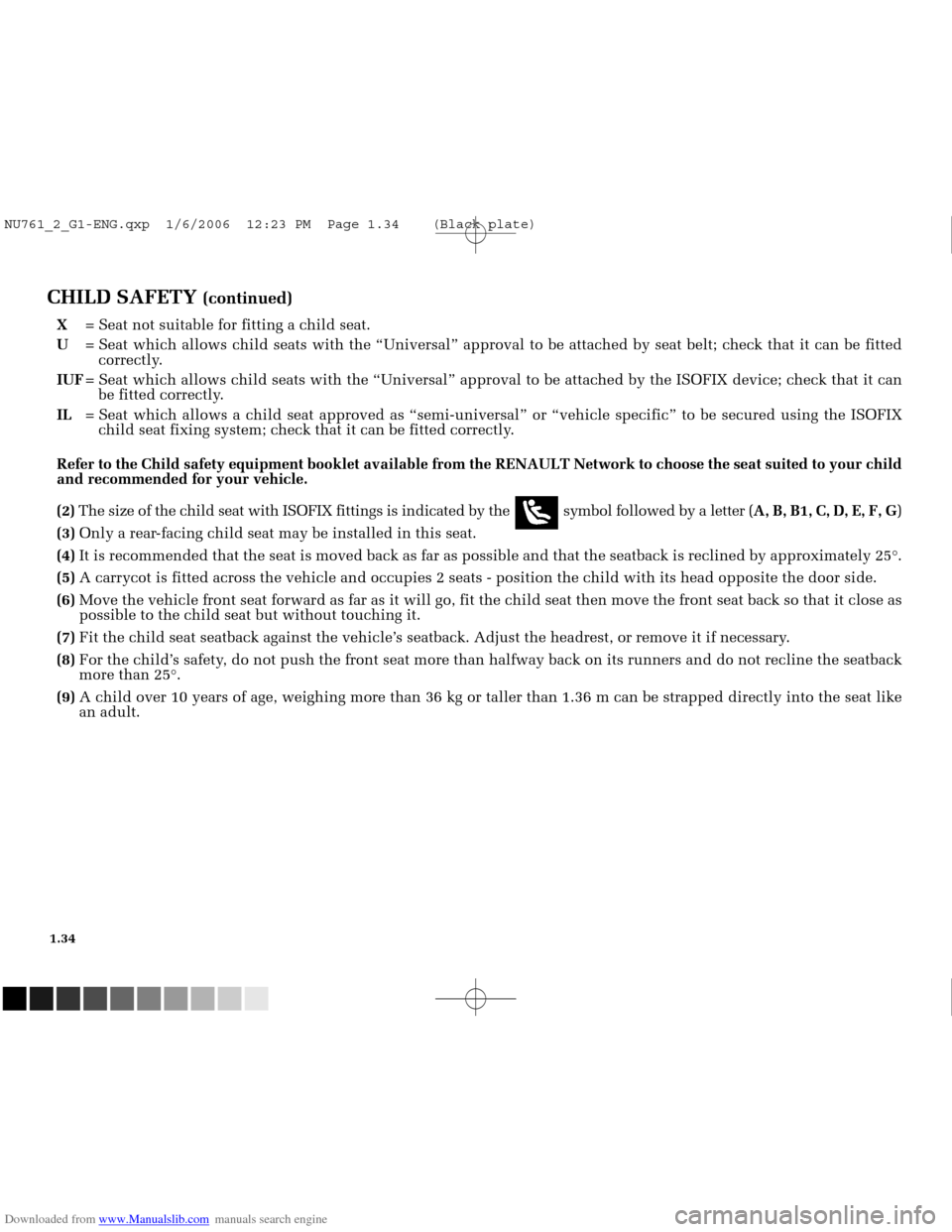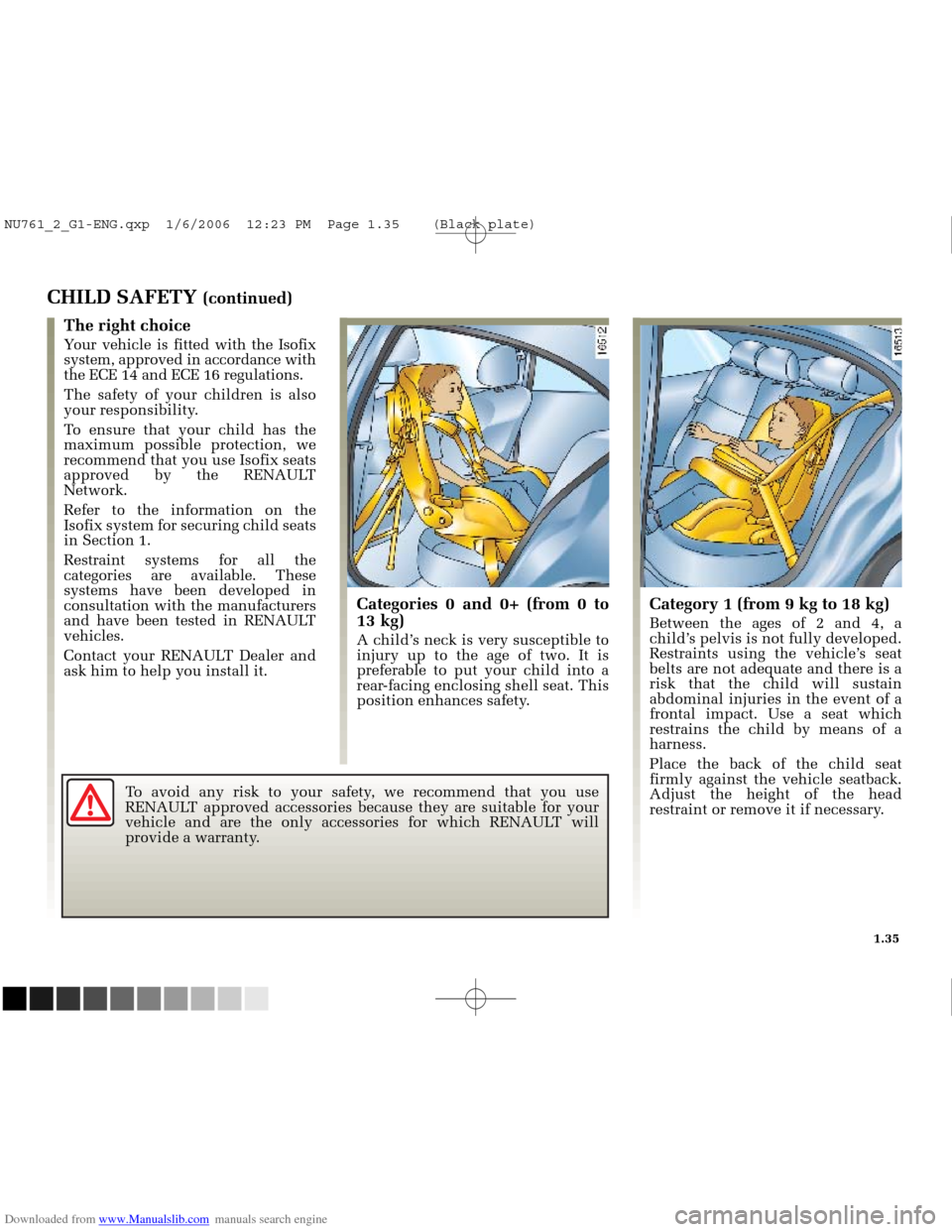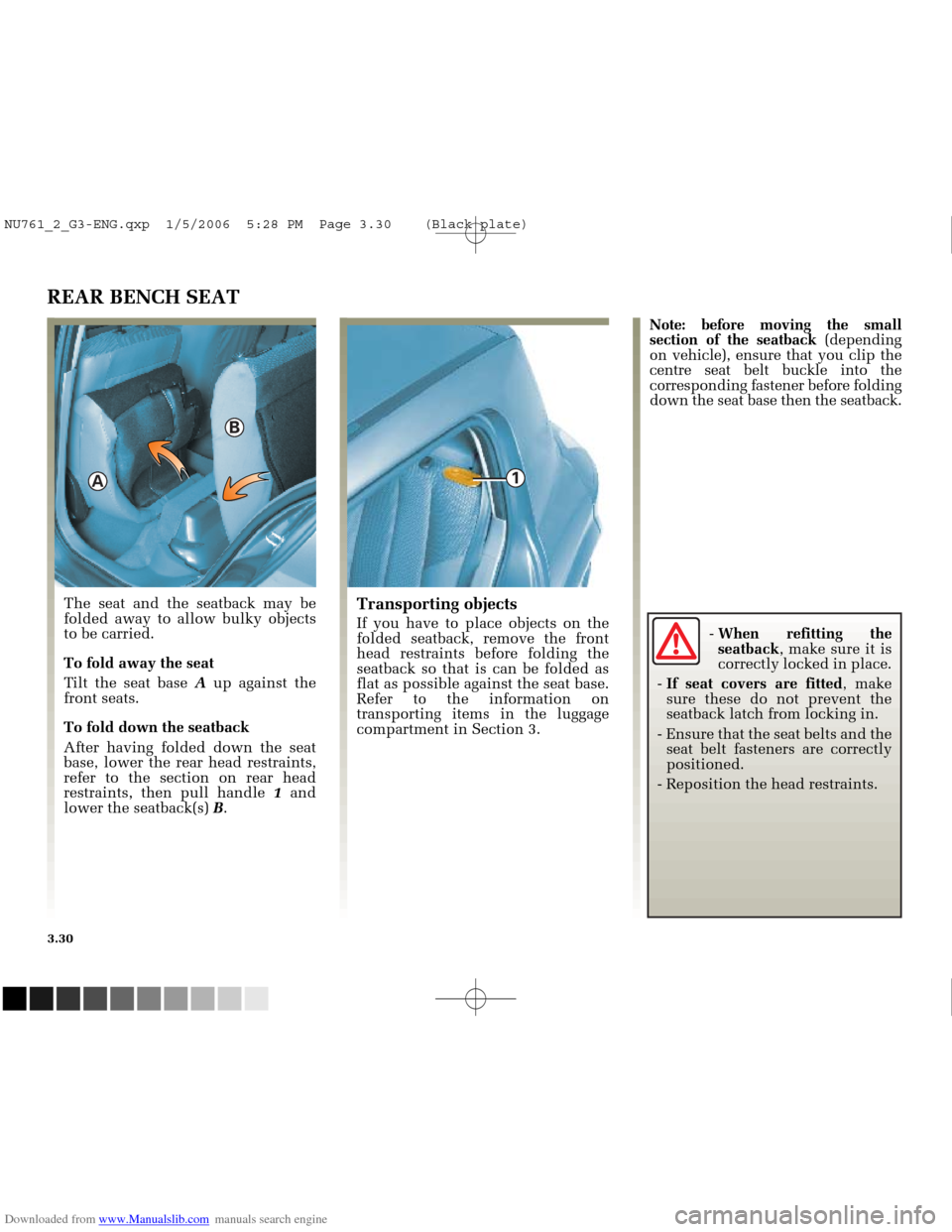Page 44 of 250

Downloaded from www.Manualslib.com manuals search engine
NU761_2_G1-FRA.qxd 10/11/05 15:53 Page 1.34
1.34
CHILD SAFETY (continued)
X= Seat not suitable for fitting a child seat.
U = Seat which allows child seats with the “Universal” approval to be \
attached by seat belt; check that it can be fitted
correctly.
IUF = Seat which allows child seats with the “Universal” approval to be \
attached by the ISOFIX device; check that it can
be fitted correctly.
IL = Seat which allows a child seat approved as “semi-universal” or “\
vehicle specific” to be secured using the ISOFIX
child seat fixing system; check that it can be fitted correctly.
Refer to the Child safety equipment booklet available from the RENAULT N\
etwork to choose the seat suited to your child
and recommended for your vehicle.
(2) The size of the child seat with ISOFIX fittings is indicated by the symbol followed by a letter ( A, B, B1, C, D, E, F, G)
(3) Only a rear-facing child seat may be installed in this seat.
(4) It is recommended that the seat is moved back as far as possible and tha\
t the seatback is reclined by approximately 25°.
(5) A carrycot is fitted across the vehicle and occupies 2 seats - position \
the child with its head opposite the door side.
(6) Move the vehicle front seat forward as far as it will go, fit the child \
seat then move the front seat back so that it close as
possible to the child seat but without touching it.
(7) Fit the child seat seatback against the vehicle’s seatback. Adjust the headrest, or remove it if necessary.
(8) For the child’s safety, do not push the front seat more than halfway back on its runners and d\
o not recline the seatback
more than 25°.
(9) A child over 10 years of age, weighing more than 36 kg or taller than 1.\
36 m can be strapped directly into the seat like
an adult.
NU761_2_G1-ENG.qxp 1/6/2006 12:23 PM Page 1.34 (Black plate)
Page 45 of 250

Downloaded from www.Manualslib.com manuals search engine
NU761_2_G1-FRA.qxd 10/11/05 15:53 Page 1.35
1.35
To avoid any risk to your safety, we recommend that you use
RENAULT approved accessories because they are suitable for your
vehicle and are the only accessories for which RENAULT will
provide a warranty.
CHILD SAFETY (continued)
The right choice
Your vehicle is fitted with the Isofix
system, approved in accordance with
the ECE 14 and ECE 16 regulations.
The safety of your children is also
your responsibility.
To ensure that your child has the
maximum possible protection, we
recommend that you use Isofix seats
approved by the RENAULT
Network.
Refer to the information on the
Isofix system for securing child seats
in Section 1.
Restraint systems for all the
categories are available. These
systems have been developed in
consultation with the manufacturers
and have been tested in RENAULT
vehicles.
Contact your RENAULT Dealer and
ask him to help you install it.
Categories 0 and 0+ (from 0 to
13 kg)
A child’s neck is very susceptible to
injury up to the age of two. It is
preferable to put your child into a
rear-facing enclosing shell seat. This
position enhances safety.
Category 1 (from 9 kg to 18 kg)
Between the ages of 2 and 4, a
child’s pelvis is not fully developed.
Restraints using the vehicle’s seat
belts are not adequate and there is a
risk that the child will sustain
abdominal injuries in the event of a
frontal impact. Use a seat which
restrains the child by means of a
harness.
Place the back of the child seat
firmly against the vehicle seatback.
Adjust the height of the head
restraint or remove it if necessary.
NU761_2_G1-ENG.qxp 1/6/2006 12:23 PM Page 1.35 (Black plate)
Page 168 of 250

Downloaded from www.Manualslib.com manuals search engine
A
1
B
NU761_2_G3-FRA.qxd 4/11/05 10:52 Page 3.30
3.30
REAR BENCH SEAT
The seat and the seatback may be
folded away to allow bulky objects
to be carried.
To fold away the seat
Tilt the seat base Aup against the
front seats.
To fold down the seatback
After having folded down the seat
base, lower the rear head restraints,
refer to the section on rear head
restraints, then pull handle 1and
lower the seatback(s) B.Transporting objects
If you have to place objects on the
folded seatback, remove the front
head restraints before folding the
seatback so that is can be folded as
flat as possible against the seat base.
Refer to the information on
transporting items in the luggage
compartment in Section 3. Note: before moving the small
section of the seatback
(depending
on vehicle), ensure that you clip the
centre seat belt buckle into the
corresponding fastener before folding
down the seat base then the seatback.
- When refitting the
seatback , make sure it is
correctly locked in place.
- If seat covers are fitted , make
sure these do not prevent the
seatback latch from locking in.
- Ensure that the seat belts and the seat belt fasteners are correctly
positioned.
- Reposition the head restraints.
NU761_2_G3-ENG.qxp 1/5/2006 5:28 PM Page 3.30 (Black plate)
Page 172 of 250
Downloaded from www.Manualslib.com manuals search engine
A
B
NU761_2_G3-FRA.qxd 4/11/05 10:52 Page 3.34
3.34
TRANSPORTING OBJECTS IN THE LUGGAGE COMPARTMENT
Always position the objects
transported so that the largest
surface is against:
- The rear seatback for normal loads
(example A).
- The folded down seat for maximum loads (example B). If you have to place objects on the
folded seatback, remove the front
head restraints before folding the
seatback so that is can be folded as
flat as possible against the seat base.
Always position the
heaviest items directly on
the floor. Use the lashing
points on the luggage
compartment floor, if these are
fitted to the vehicle. The luggage
should be loaded in such a way
that no items will be thrown
forward and strike the occupants
if the driver has to brake
suddenly. Fasten the rear seat
belts, even if the seats are not
occupied.
NU761_2_G3-ENG.qxp 1/5/2006 5:28 PM Page 3.34 (Black plate)